International Security Risks in the Azov-Black Sea Region in November-December 2021
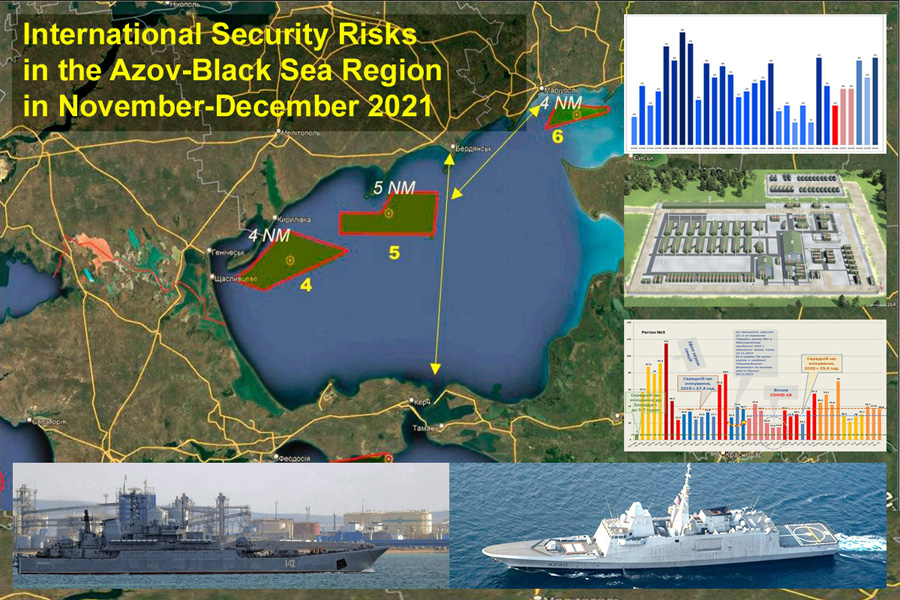
The Monitoring Group
of the Black Sea Institute of Strategic Studies and BlackSeaNews
As part of the Monitoring on Risks to International Security in the Azov-Black Sea Region, the Monitoring Group of the Black Sea Institute of Strategic Studies and the editorial board of BlackSeaNews presents below a brief summary of its findings and conclusions. Over November-December 2021, the Group has been monitoring the following issues that pose international security risks in the Azov-Black Sea region:
-
Obstruction of traffic in the Black Sea by the Russian Federation Due to Closures of Sea Areas for or Under the Pretext of Military Exercises.
-
Obstruction of Traffic in the Sea of Azov by the Russian Federation
-
The Presence of Russian Navy Ships in the Mediterranean Sea.
-
Russian Military Exercises in the Azov-Black Sea Region.
-
Visits of NATO Non-Black Sea States' Ships to the Black Sea.
The results are as follows:
* * *
1. Obstruction of traffic in the Black Sea by the Russian Federation Due to Clo-sures of Sea Areas for or Under the Pretext of Military Exercises
On 27 October 2021, by transmitting international Coastal Warning alerts in the NAVTEX (NAVigational TEleX) messaging system, the Russian Federation (RF) announced the closure until 15 November 2021, i.e. for 20 days, of a large number of Black Sea areas (See Figure 1, where areas covered by the RF's an-nouncement are shaded in green).
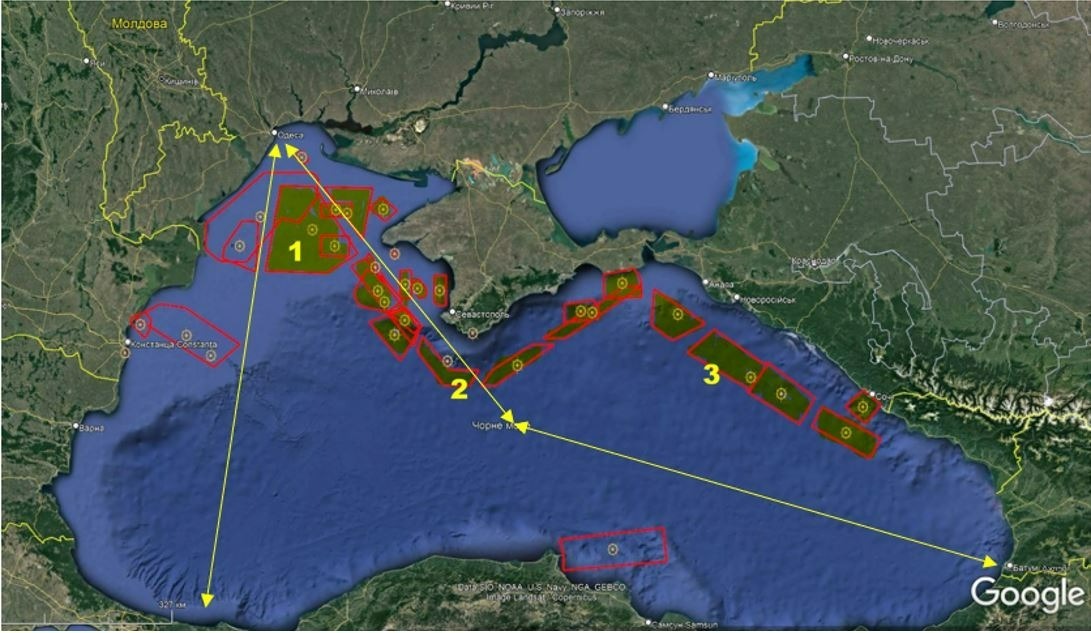
1 – the area of the Ukrainian offshore natural gas fields on the sea shelf seized at the beginning of the Crimea occupation. The area is in close proximity to the main sea route from the Bosphorus to all Ukrainian Black Sea ports — namely, Chornomorsk, Odesa, Mykolaiv, and Kherson — with the route from Odesa to Georgia also passing through the area. Thus, the closure creates a constant threat to all Ukraine's maritime traffic;
2 – the area that blocks access to the coast of the occupied Crimean Peninsula;
3 – the area that blocks access to the Black Sea coast of Russian Krasnodar Kray from the Kerch Strait to the city of Sochi.
The closures were due to the U.S. Sixth Fleet's ships conducting joint Black Sea exercises with the Navies of Ukraine, Georgia, Turkey, Romania, and Bulgaria, namely:
- The guided missile destroyer USS Porter (DDG 78): 30 Oct. – 16 Nov. 2021.
- The replenishment oiler USNS John Lenthall (T-AO-189): 03 Nov. – 14 Nov. 2021.
- The flagship of the U.S. Sixth Fleet USS Mount Whitney (LLC 20): 04 Nov. – 15 Nov. 2021.
On 16 November 2021, i.e. after the U.S. Navy ships' departure from the Black Sea, those navigation re-strictions were lifted, with only the traditional Russian Black Sea Fleet combat training areas remaining closed, as they had been almost continuously.
Apart from the aforementioned closures of the Black Sea and the Sea of Azov areas, we must draw atten-tion to the Kerch Strait entrance closures for warships and other vessels — such as hydrographic and res-cue ones — of other states (See Figure 2, p. 8).

It should be noted that it is the first time that all access to the Kerch Strait has been shut down, as before, the RF used to always leave a corridor between the closed areas.
The closure was announced in April 2021 for the period from 16 April to 31 October 2021, i.e. for over six months.
Subsequently, the area closure was extended from 31 October to 15 November due to the presence of the three U.S. warships men-tioned above
Reference: the information on such closures is not displayed in the NAVAREA system, as these ar-eas are within the 12-mile zone (in the case of the Crimean Peninsula, the Russian Federation con-siders it its territorial sea).
On 29 November 2021, the Russian Black Sea Fleet again closed the area of Ukrainian offshore natural gas fields seized at the start of the Crimean occupation (See Figure 1, p.1). As of 15 December 2021, this area, which is in close proximity to the main sea route from the Bosphorus to all Ukrainian Black Sea ports, re-mains closed.
That again could be related to the presence of the USS Arleigh Burke (DDG 51) patrolling the Black Sea from 25 November to 15 December 2021. However, unlike the 27 October – 15 November period, this time, the RF has not created a "buffer", similar to that shown in Figure 1, by closing the areas along the coast of Crimea and Russia's Krasnodar Kray.
On 8 December 2021, in addition to the previously closed areas, under the pretext of naval gunnery firing exercises, the RF closed for one month, i.e. until 8 January 2022, all three areas of the Sea of Azov directly adjacent to the Ukrainian coast and Ukraine's ports on the Sea of Azov (See Figures 3 and 4).
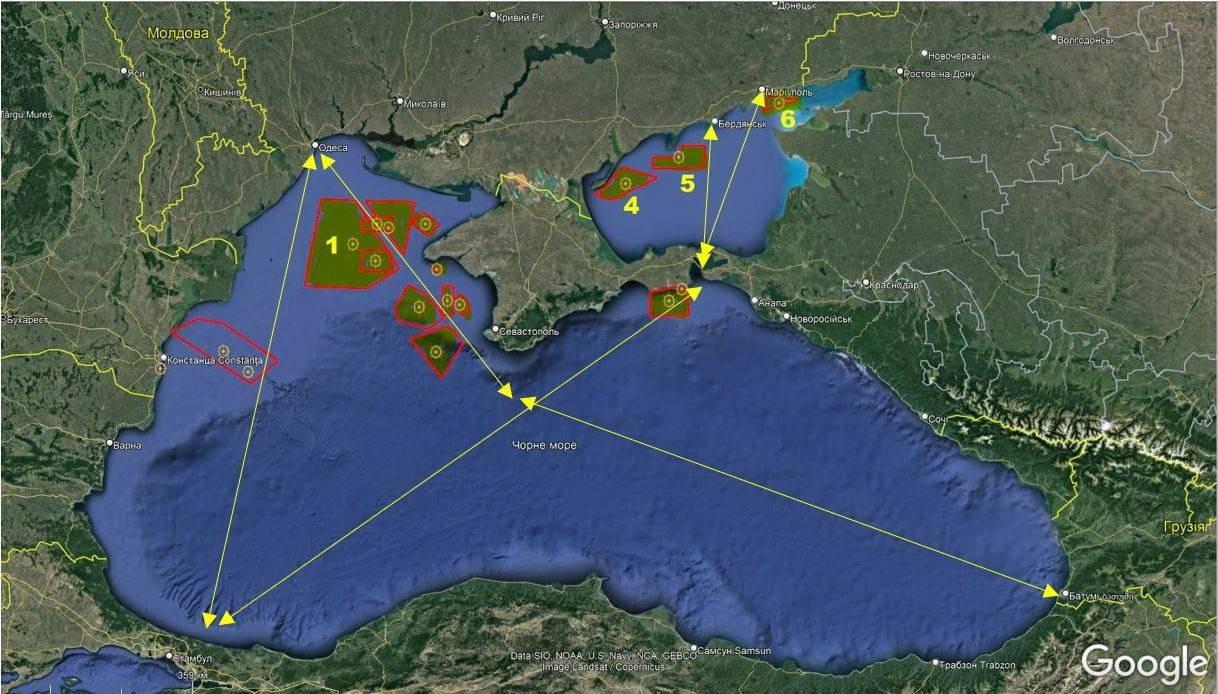
1 – the area of the Ukrainian offshore natural gas fields on the sea shelf seized at the beginning of the Crimea occupation. The area is in close proximity to the main sea route from the Bosphorus to all Ukrainian Black Sea ports — namely, Chornomorsk, Odesa, Mykolaiv, and Kherson — with the route from Odesa to Georgia also passing through the area. Thus, the closure creates a constant threat to all Ukraine's maritime traffic;
4 – the Azov coast of the Genichesk district of the Kherson region of Ukraine, which directly borders occupied Crimea;
5 - the Azov coast of the city and port of Berdiansk;
6 – the Azov coast of the city and port of Mariupol, which directly borders the occupied coast of the Novoazovsk district of the Donetsk region of Ukraine (currently part of the so-called ORDLO);
7 –the part of the Opuk training area and range on the Kerch Peninsula in Crimea, closed for military exercises.
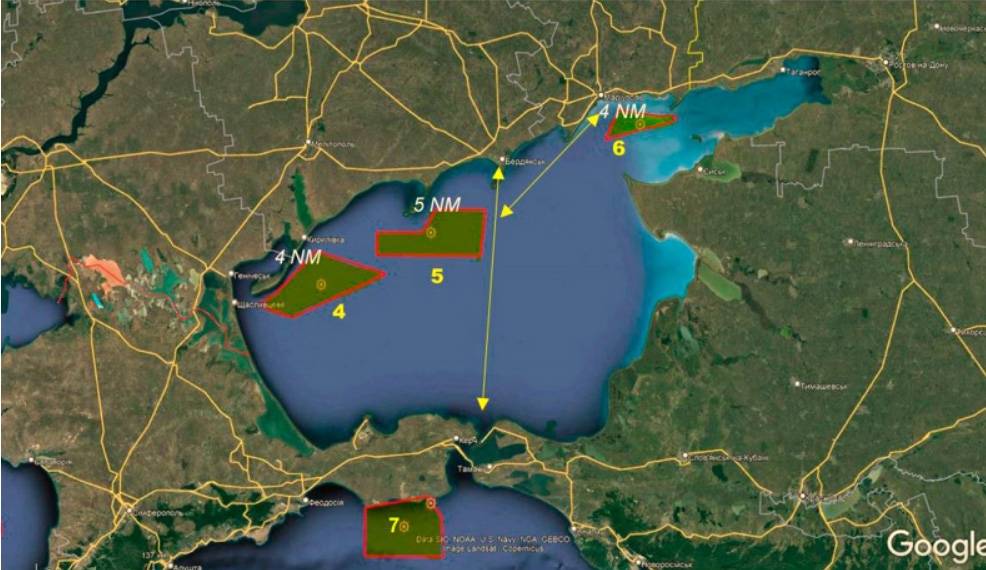
According to the Ukrainian Navy Command, the distance from the borders of the closed Sea of Azov are-as, where ships and boats of Russia's Black Sea Fleet and Coast Guard of the FSB Border Service conduct gunnery firing exercises, to the relevant areas of the Azov coast of Ukraine is 4 -5 nautical miles (NM) or 7.4 – 9.3 km (See Figure 4).
Thus, in 2021, Russia has demonstrated that when it comes to blocking sea areas under the pre-text of military exercises, it has no limits. There is no doubt that this practice will continue. Such a scheme of sea areas closures has created three main possibilities posing security risks:
► an accidental or purposeful provocation involving the use of weapons, which can lead to mil-itary escalation in the Sea of Azov;
► a rapid simultaneous blockade of all Ukraine's seaports on the Black Sea and the Sea of Azov;
► an amphibious operation on the Ukrainian Sea of Azov coast from Genichesk to Mariupol, as the coastal terrain is conducive to it.
* * *
1.1. The Closure of the Azov Coast of Ukraine, Ships of Russia's Black Sea Fleet in the Sea of Azov, and the Information and Psychological Cover Operation Re-lated to the Ukrainian Ship Donbas
An indirect confirmation of Russia's preparation for an amphibious operation on the Ukrainian Sea of Azov coast is the situation that developed on 8 December 2021, the very first day of the aforementioned areas of the Sea of Azov closure for gunnery firing exercises.
On 7 December 2021, the Ministry of Defence of the Russian Federation announced that two large am-phibious ships of the Russian Black Sea Fleet, Novocherkassk and Caesar Kunikov,
loaded "military equipment and marine units personnel in Sevastopol." It was also reported that "the next stage of combat training for the crews of the ships carrying marine units would involve the marines landing at the Opuk joint training area and range" — that is, in occupied Crimea.
The Opuk training area and range is located on the Black Sea coast of the occupied Crimea's Kerch Penin-sula, between Feodosiia and Kerch (See Figure 4, p. 7).
However, on 8 December 2021, the large amphibious ship Caesar Kunikov was already in the Bosphorus Strait, and on 10 December 2021, the large amphibious ship Novocherkassk was in the Kerch Strait – already at the exit from the Sea of Azov.
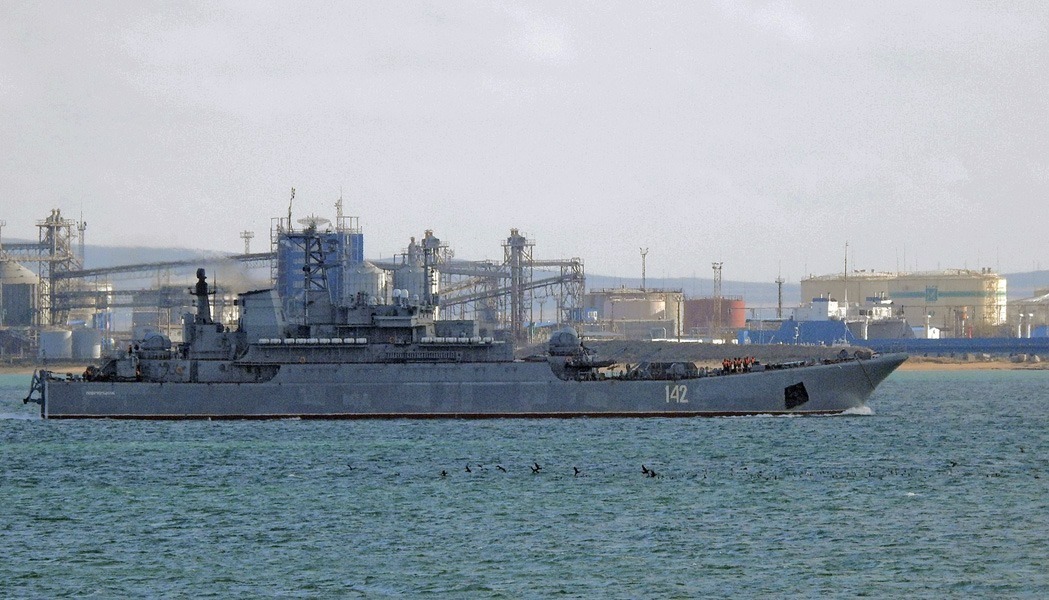
Thus, the news on the Russian Ministry of Defence website has turned out to be a purposeful military disinformation.
Most likely, on 8 December, the large amphibious ship Novocherkassk entered the Sea of Azov and stayed there until the afternoon of 10 December, which gave it enough time to take part in exercises near the Ukrainian coast and acquaint the crew and amphibious force with the possible theatre of war.
Note that according to volunteers, at approximately 21.00-21.30 EET on 9 December 2021, the Russian Black Sea Fleet missile boat Shuya (hull number 962), which also unexpectedly appeared in the Sea of Azov, on an open radio channel threatened the Ukrainian ship Donbas with opening fire if the latter didn't change course.
Right then, on 9 December 2021, that is during an uncommon presence of a large amphibious ship and a missile boat of the Russian Black Sea Fleet in the Sea of Azov in addition to the usual ships of the FSB Coast Guard, the FSB website published the following news item:
At 9:12 a.m. on 9 December of this year, the command ship Donbas of the Ukrainian Navy left the port of Mariupol and started moving towards the Kerch Strait. The Ukrainian side had not submit-ted applications for the passage through the Kerch-Yenikalsky Canal in accordance with the sea-port of Kerch Compulsory Regulations, approved by Order No. 313 of the Ministry of Transport of the Russian Federation of 21 October 2015. At 13:45, the Russian FSB Border Service Coast Guard ship accompanying it warned the vessel of the need to comply with Russian legislation in part con-cerning the filing of the necessary applications for passage through the Kerch Strait. The answer received stated that the ship did not plan to pass through the Kerch Strait. At present, the Donbas ship is located at a distance of 18 nautical miles from the Kerch Strait and does not follow the re-quirement to change the course. These actions pose a threat to the safety of navigation.
Within minutes that contrived and false statement was picked up by Russia's leading state news agencies, other mass media, and social media, which used an already habitual hysterical tone. The message was also later quoted by foreign media.
We believe that the immediate hysterical reaction of the Russian media to the FSB report on the Donbas ship is part of the special information and psychological operation, aimed, among other things, at divert-ing attention from the closure of the Sea of Azov areas near the Ukrainian coast during the Russian Black Sea Fleet vessels' presence in the area.
► Overall, as far as closures of the Black Sea areas are concerned, from 1 November to 13 De-cember 2021, we observed a situation that had become standard.
► The situation in the Sea of Azov shows clear signs of rising tensions and preparation for an amphibious operation on the Ukrainian coast between Genichesk and Mariupol.
► The simultaneous closures of access areas to Ukrainian ports in both the Black Sea and the Sea of Azov for naval exercises may indicate the preparation of a plan for a swift simultaneous blockade of all Ukrainian seaports on both seas.
For reference: Ukraine's seaports account for over 37% of Ukraine's total international trade volume, including more than 57% of its exports.
The full text of the analytical report in English: Closure of the Azov-Black Sea Region in November-December 2021.
* * *
2. Obstruction of Traffic in the Sea of Azov by the Russian Federation
In November 2021, vessels carrying exports from Mariupol and Berdiansk were delayed at the exit from the Sea of Azov by the Russian Federation for an average of 36.8 hours per vessel. For comparison, the average figure for 2020 was 29.6 hours; for October 2021 – 37.9 hours (See Figure 5).
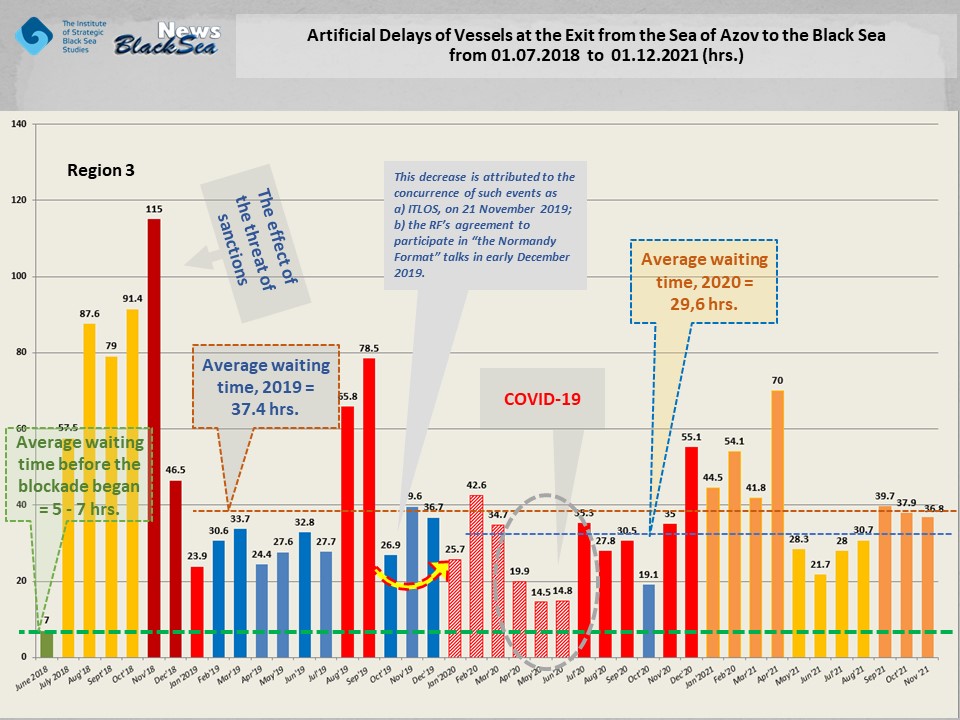
From December 2018 to December 2020, due to the threat of the "Azov package" of interna-tional sanctions against Russian ports on the Sea of Azov, there was a slight decrease in the average duration of artificial delays of ships at the exit from the Sea of Azov to the Black Sea: in 2018 − 79.5 hours; in 2019 − up to 37.4 hours; in 2020 − 29.6 hours per vessel.
However, over the first 11 months of 2021, the average duration of artificial delays at the entry to the Kerch Strait by the RF of ships carrying export cargoes from the Ukrainian ports, has in-creased significantly to 39.4 hours per vessel and already exceeded the figures for 2019 and 2020 (37.4 and 29.6 hours per vessel respectively).
Of the 61 merchant vessels that passed through the Kerch Strait from the Ukrainian ports on the Sea of Azov, carrying export cargoes, 33 were related to EU countries on the basis of the flag state, and/or the shipowner's country of registration, and/or the port of destination.
The average wait time for a permit to pass through the Kerch Strait overall was 39.1 hours per vessel, and for vessels related to EU countries – almost the same – 36.8 hours per vessel.
► Thus, as far as this indicator of the international security risk in the Azov-Black Sea region is con-cerned, we have observed a significant deterioration of the situation.
The full text of the analytical report in English: The Duration of Artificial Delays of Vessels in the Kerch Strait. The Monitoring for November 2021
* * *
3. The Presence of Russian Navy Ships in the Mediterranean Sea
As of 15 December 2021, the standard composition of the naval group of the Black Sea Fleet of the Russian Federation is present in the Mediterranean Sea (see Table 3 in the Appendix):
- guided missile frigate – 1 (494 Admiral Grigorovich),
- guided missile corvette – 1 (609 V. Volocheck),
- patrol corvette – 1 (375 Dmitriy Rogachev),
- improved Kilo-class submarines – 2 (237 Rostov na Donu, 265 Krasnodar),
- large amphibious ship – 1 (158 Tsezar Kunikov ),
- minesweeper – 1 (908 Vice-Admiral Zakharin),
- anti-sabotage boat – 1 (840 Kadet),
- intelligence ship – 1 (Kildin),
- tanker (auxiliary ship) – 1 (Vice Admiral Paromov).
The level of security risks in the Azov-Black Sea region is likely to increase in the near future due to the redeployment to the Black Sea of 2 large amphibious ships from the Baltic Fleet, which arrived at the Russian naval base in the Syrian port of Tartus after 22 November 2021.
The redeployment of the two large amphibious ships of the Baltic Fleet, Korolev (130) and Minsk (127), to the Black Sea, which is expected in the near future, will significantly strengthen the Black Sea Fleet's amphibious ships brigade, which currently has 6 large amphibious ships (+ 1 under repair), and consequently will increase the risks of amphibious operations on the Ukraini-an coast.
For reference: during the "April escalation," 4 large amphibious ships were temporarily rede-ployed to the Black Sea: 2 from the Baltic Fleet and 2 from the Northern Fleet.
► Thus, as of December 15, 2021, the usual standard composition of the ship group of the Black Sea Fleet of the Russian Federation is located in the Mediterranean Sea.
* * *
4. Russian Military Exercises in the Azov-Black Sea Region
In September 2021, 129 exercises of the troops of the Southern Military District of the Russian Federation (including the Black Sea Fleet) were recorded, in October 2021 – 143, and in November 2021 – 95.
The decrease in the number of exercises in November is due to the end of the "summer period of train-ing" in the Russian army, which lasts from June to October.
Unlike in previous years, the Russian army did not have the usual period of "relaxation" at the be-ginning of the "winter period of training," which lasts from November to April. At the request of the Minister of Defence , intensive exercises resumed immediately from 1 November 2021.
Of the total of 95 exercises reported in November 2021, 23% concerned conducting airborne assault, amphibious, and sabotage operations on the territory of the opposing force by marines, special forces, and sabotage groups with the support of aviation.
The operating procedure for preparing for the redeployment of aircraft to alternate and operational airfields was also drilled.
In November-December 2021, 9 modern autonomous modular field camps APL-500 – with a capacity of 500 servicemen and the corresponding amount of equipment each – made in the Russian Federation were installed for the first time to provide intensive training in winter conditions at all 9 joint training areas and ranges in the Southern Military District of the Russian Federation.
They included training areas and ranges in Astrakhan, Volgograd, and Rostov Oblasts, Stavropol and Krasnodar Krays, North Ossetia, and occupied Crimea.
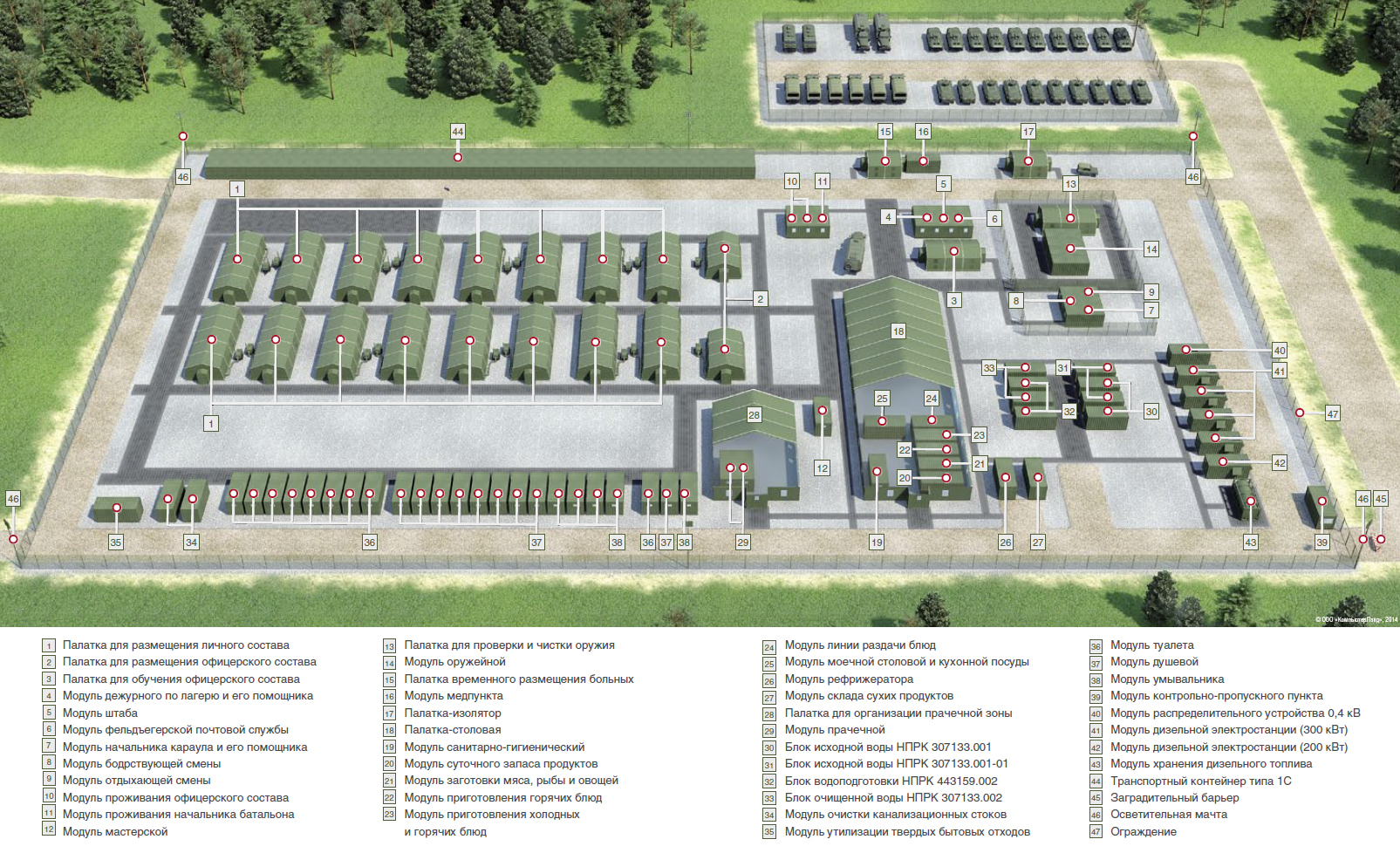
taxpayer identification number 7811502572
Reference from the official description:
APL-500 is used by the Armed Forces of the Russian Federation for performing any tasks related to the presence of troops outside the permanent deployment area:
- in the process of combat training of troops for the organization of exercises, field trips, camp assemblies, long marches with daily rest during the period of mission integration training;
- in case of the need for fast preparation of servicemen of the reserve of the constituent entities of the Russian Federation;
- during the strategic deployment of the armed forces on mobilization;
- when securing national frontiers; during peacekeeping operations and participation in local conflicts outside the areas of direct confrontation with the enemy; in a period of liquidation of natural and man-made disasters;
- in the process of construction and protection of railways, autonomous power plants, hydroelectric complexes, oil and gas pipelines, ports and airfields;
- when performing tasks in a state of emergency or armed conflict.
1 November 2021. Engineers of the 49th Combined Arms Army of the Southern Military District in Krasno-dar Kray received a set of heavy mechanized bridges TMM-3M2.
These bridges are designed for crossing the gaps of up to 40 metres wide and 3.5 metres deep by wheeled and tracked vehicles weighing up to 60 tons. It takes up to 45 minutes to organize one crossing with the help of the mechanized bridge. Eight people are involved in assembling such a bridge. On 22 November 2021, military engineers of the 49th Combined Arms Army used this equipment during exercises.
22 November 2021. The crews of the attack helicopters Mi-28N Nochnoy Okhotnik, Ka-52 Alligator, and Mi-35M of the air regiment based in Krasnodar Kray performed special tasks in the mountain-forest and plain terrain at night, using night-vision devices.
The pilots practised fire support of air defence assault units, escorting convoys during the advance, redeployment and landing of tactical airborne troops, de-livery of ammunition and various military cargoes to hard-to-reach areas of forests and mountains..
23 November 2021. The crew of the Veliky Novgorod submarine of the Black Sea Fleet had training in the installation of underwater mine barriers in the naval training area in the Black Sea on the intended route of the naval groups of the opposing force.
On 15 December 2021, the Rosgvardiya and the departmental security service of the Russian Ministry of Transport conducted training on the Kerch Bridge in searching passengers for explosives.
Note also the following important trends:
-
In September 2021, in the Southern Military District of the Russian Federation, for the first time, over 50 sabotage groups of special operations units simultaneously participated in command post exercises.
-
In Rostov Oblast, a territorial defence division is being formed, which is part of the mobilization re-serve BARS (combat army reserve of the country).
The first reserve training camps involving BARS air defence units were held on 23 September 2021. For this purpose, 23 training facilities were deployed at 9 training areas and ranges of the district, and 240 officers and sergeants were selected to be in charge of the training. Training is carried out as part of camp assemblies. They are still going on in various regions of the European part of the Russian Feder-ation. For example, in Stavropol Kray alone, more than 7,000 contracts have been concluded with citi-zens who want to replenish units of the combat army reserve.
Reservists of the Russian Federation are guaranteed payment. For three days of training, an officer will receive up to 10 thousand roubles, a sergeant-soldier – up to 5 thousand roubles. For 30 days of participation in reserve training camps, an officer will receive from 30 to 75 thousand roubles, a soldier – up to 25 thousand roubles. The first contract for enrolment in the reserve is concluded for three years. The next one can be signed for five years or until a serviceman reaches the age limit.
-
In the autumn of 2021, the Russian Defence Ministry began training airborne troops for regular large-scale landings at night.
An experiment on air landing of large forces at night was conducted at the Russian-Belarusian exer-cise Zapad-2021. At that time, about 600 troops and 30 units of equipment – armoured personnel car-riers and airborne assault vehicles – conducted landings as part of the exercise.
Now such landings are planned to be practised on an even larger scale – night landings will become one of the tactical elements to be included in a new concept of using airborne troops. The concept should be submitted by the end of 2021.
► In general, we can conclude that the Russian Federation is preparing for war – especially for modern local sabotage, airborne assault, and amphibious operations on the ground and at sea – not only at the level of the rhetoric of politicians and the media but also at the level of marked changes in the nature and intensity of combat training of the army and navy. Russia is also radically strengthening the for-mation of the military reserve.
* * *
5. Visits of NATO Non-Black Sea States' Ships to the Black Sea
In November-December 2021, five ships of non-Black Sea NATO countries have been present in the Black Sea: four of them belong to the U.S. Sixth Fleet, and one – to the French Navy:
-
The guided missile destroyer USS Porter (DDG 78): 30 Oct. – 16 Nov. 2021.
-
The replenishment oiler USNS John Lenthall (T-AO-189): 03 Nov. – 14 Nov. 2021.
-
The flagship of the U.S. Sixth Fleet USS Mount Whitney (LLC 20): 04 Nov. – 15 Nov. 2021.
-
The guided missile destroyer USS Arleigh Burke (DDG 51): 25 Nov. 2021 – 15 Dec. 2021.
-
The missile frigate of the French Navy FS Auvergne (D654) has been in the Black Sea since 13 Dec. 2021 and is still there at the time of this publication.
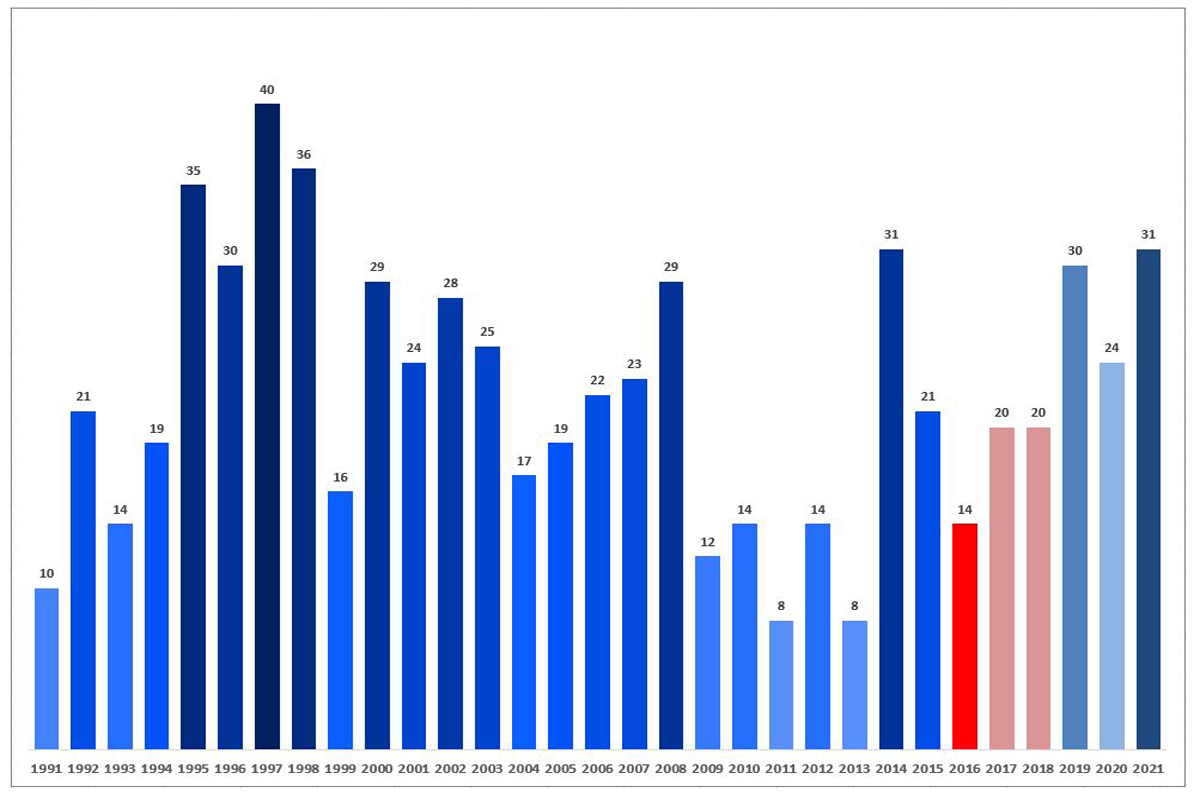
Since the Collapse of the Soviet Union (1991 – 2021)
Since the beginning of 2021, as of 15 December, 31 ships from NATO non-Black Sea states have visited the Black Sea. This is the largest number – the same as in 2014 – for the entire period of Russia's occupation of Crimea.
As in previous years, in 2021, most of the visits to the Black Sea by ships of NATO non-Black Sea countries – 13 out of 31 – have been made by the U.S. Sixth Fleet.
For reference: As of the date of publication, the breakdown of visits by country is as follows: the U.S.A. – 13; Spain – 5; the Great Britain – 3; Italy – 3; Greece – 3; France – 3; the Netherlands – 1.
At the same time, it should be noted that when planning the visits of NATO non-Black Sea states' warships to the Black Sea, some excessive caution regarding visits to the Ukrainian port of Odesa can be observed.
For reference: In 2021, of 31 visits, only in 10 cases the ships made port calls in Odesa. All visits to Odesa took place in the first half of the year. That is, the demonstration of naval solidarity with Ukraine in the second half of 2021 took place without visits to the Ukrainian port. Most likely, the rationale be-hind such planning was "not to irritate Russia once again".
It should also be noted that the level of risk of aggression by sea during the celebration of Christmas and New Year will increase if there are no NATO ships in the Black Sea at this time.
Reference: NATO Ships' Presence in the Black Sea During the New Year Holidays in 2014-2020:
-
2014: 26 Dec. 2014 − 14 Jan. 2015 − the American missile destroyer Donald Cook, Constanta (30 Dec. 2014 − 04 Jan. 2015), Varna (08-10 Jan. 2015).
-
2015: 17 Dec. 2015 − 08 Feb. 2016 − there were no NATO ships.
-
2016: 11 Dec. 2016 − 31 Jan. 2017 − there were no NATO ships.
-
2017: 09 Dec. 2017 − 05 Jan. 2018 − there were no NATO ships.
-
2018: 17 Dec. 2018 − 05 Jan. 2019 − the British hydrographic survey ship Echo, Odesa (18-22 Dec. 2018), Constanta (23-27 Dec. 2018), Batumi (29 Dec. 2018 – 02 Jan. 2019).
-
2019: 28 Dec. 2019 − 24 Jan. 2020 − there were no NATO ships.
-
2020: 02 Dec. 2020 − 23 Jan. 2021 − there were no NATO ships.
► In general, as far as this indicator is concerned, we can observe a positive trend. The almost continuous presence in the Black Sea (during the autumn escalation of the military threat from Russia) of powerful NATO missile ships is certainly an effective deterrent to the aggressor.
The full text of the analytical report in English: The Presence of NATO Non-Black Sea States’ Warships in the Black Sea in November-December 2021
* * *
6. Conclusions, Comments, and Forecasts
Taking into account the broader international context of recent weeks, our forecasts are as follows.
► In general, based on the aforementioned facts, we can conclude that Russia is continuing to pre-pare for war – primarily, for modern local sabotage, airborne assault, and amphibious operations on the ground and at sea – not only at the level of the rhetoric of politicians and the media but al-so at the level of marked changes in the nature and intensity of combat training of the army and navy. Russia is also radically strengthening the formation and training of the military reserve.
► Tightening of the blockade of Ukrainian ports on the Sea of Azov and increased obstruction of traffic in the Black Sea on the way from Ukrainian ports to the Bosphorus – to the point of the ac-tual blockade of shipping to/from the ports of the Odesa, Mykolaiv, and Kherson regions – are possible.
► The possibility of military action on the Ukrainian coast of the Sea of Azov, in particular airborne assault and amphibious operations, cannot be ruled out. Accidental or intentionally provoked in-cidents at sea with the use of weapons can provide a pretext for this.
► The risk of Russian aggression will increase during the celebration of Christmas and New Year and later – during the Winter Olympics in China.
* * *
The Summary Table of the Risks Analyzed by the Monitoring Group of the Black Sea Institute of Strategic Studies and BlackSeaNews in November-December 2021
|
Risk indicators |
|
Risk level according to monitoring results |
|
Obstruction of traffic in the Black Sea by the Russian Federation due to closures of sea areas for or under the pretext of military exercises |
|
The Black Sea – traditionally high level of risk The Sea of Azov – increased risk
|
|
|
|
|
|
Obstruction of traffic in the Sea of Azov by the Russian Federation |
|
Increased risk
|
|
|
|
|
|
The presence of Russian Navy ships in the Mediterranean Sea |
|
Traditional level of risk
|
|
|
|
|
|
Russian military exercises in the Azov-Black Sea region |
|
Increased risk
|
|
|
|
|
|
Visits of NATO non-Black Sea states' ships to the Black Sea |
|
Significant level of risk mitigation
|
* * *
 This article has been prepared with the support of the European Union in Ukraine. The content of the article is the sole responsibility of the authors and does not necessarily reflect the position of the EU
This article has been prepared with the support of the European Union in Ukraine. The content of the article is the sole responsibility of the authors and does not necessarily reflect the position of the EU
More on the topic
- 04.11.2023 Deployment of Russian Warships in the Mediterranean as of November 1, 2023
- 31.05.2023 Deployment of Russian Warships in the Mediterranean as of May 31, 2023
- 06.11.2022 The presence of Russian warships in the Mediterranean Sea as of 6 November 2022
- 12.10.2022 The Presence of Russian Warships in the Mediterranean Sea as of 10 October 2022
- 16.09.2022 The Presence of Russian Warships in the Mediterranean Sea as of 15 September 2022
- 11.05.2022 The Presence of Russian Warships in the Mediterranean Sea as of 10 May 2022
- 09.03.2022 The Presence of Russian Warships in the Mediterranean Sea as of 9 March 2022
- 15.02.2022 Increased Risks. Obstruction of Traffic in the Black and Azov Seas by Russia due to the Closure of Sea Areas for Military Exercises as of 15 February 2022
- 01.02.2022 The Presence of Russian Warships in the Black Sea and the Mediterranean Sea in January 2022